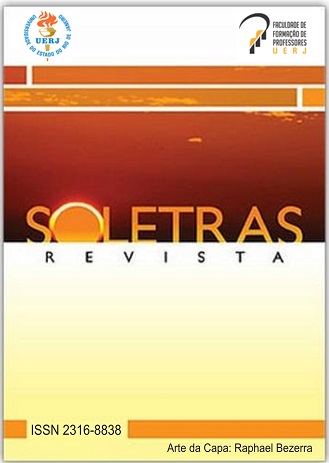Onde vivem os monstros: um breve passeio por entre o livro e o filme
DOI:
https://doi.org/10.12957/soletras.2024.85065Resumo
A partir de uma leitura comparativa de Onde vivem os monstros (1963), considerada por muitos a obra máxima de Maurice Sendak, e do filme homônimo (2009), de Spike Jonze, buscamos neste estudo identificar pontos de aproximação e de distanciamento entre as obras e de que modo recorrem às especificidades de suas próprias linguagens para a construção de sentidos. Recorre-se, para o alcance desse intento, a um estudo bibliográfico, qualitativo e de cunho hipotético-dedutivo, o qual está amparado principalmente, pelas reflexões de Linden (2011), Moraes (2023) e Nodelman (1988), no que tange às teorias referentes ao livro-álbum, e pelos estudos de David Bordwell (1985), no que concerne ao cinema. Observamos, a partir das leituras empreendidas, que, se o livro propõe inovações no que se refere à construção da arquitetura do livro-álbum, explorando com maestria a tríade texto verbal, ilustração e projeto gráfico; o filme inova em termos temáticos. Assim, nota-se que, tanto o leitor quanto o espectador dessas obras precisam estar abertos à leitura de traços e características temáticas, materiais e/ou estéticas inovadoras, assumindo um papel ativo para suas respectivas fruições.
Downloads
Publicado
Edição
Seção
Licença
A aprovação dos artigos implica a cessão imediata e sem ônus dos direitos de publicação nesta revista. O(s) autor(es) autoriza(m) ao Programa de Pós-graduação em Letras e Linguística (PPLIN) a reproduzi-lo e publicá-lo na revista SOLETRAS, entendendo-se os termos “reprodução” e “publicação” conforme definição do artigo 5° da Lei 9610/98. O(s) autor(es) continuará(rão) a ter os direitos autorais para publicações posteriores. O artigo poderá ser acessado pela rede mundial de computadores (http://www.e-publicacoes.uerj.br/index.php/soletras), sendo permitidas, a título gratuito, a consulta e a reprodução de exemplar do artigo para uso próprio de quem o consulta. Casos de plágio ou quaisquer ilegalidades nos textos apresentados são de inteira responsabilidade de seus autores.



